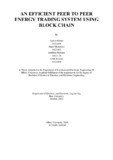| dc.contributor.advisor | Huda, A. S. Nazmul | |
| dc.contributor.author | Hassan, Yamin | |
| dc.contributor.author | Mazumder, Sagar | |
| dc.contributor.author | Rahman, Ashfakur | |
| dc.contributor.author | Hossain, Ashik | |
| dc.date.accessioned | 2021-03-21T08:09:29Z | |
| dc.date.available | 2021-03-21T08:09:29Z | |
| dc.date.copyright | 2020 | |
| dc.date.issued | 2020-08 | |
| dc.identifier.other | ID: 16321024 | |
| dc.identifier.other | ID: 16121035 | |
| dc.identifier.other | ID: 16121126 | |
| dc.identifier.other | ID: 15121034 | |
| dc.identifier.uri | http://hdl.handle.net/10361/14368 | |
| dc.description | This thesis is submitted in partial fulfillment of the requirements for the degree of Bachelor of Science in Electrical and Electronic Engineering, 2020. | en_US |
| dc.description | Cataloged from PDF version of thesis. | |
| dc.description | Includes bibliographical references (pages 78-82). | |
| dc.description.abstract | The energy sector of Bangladesh is highly dependent on fossil fuels. This situation has led to increased carbon dioxide emission over the years. However, the government is strongly advocating for the installation of green renewable energy sources. This has fostered an increased adoption of PV generation systems. The net-metering system has been deployed in the country to allow PV owners to sell their excess energy generated. The P2P model, however, is gaining significant interest. Dhaka is one of the largest electricity consumers in the country. Therefore, an analysis has been conducted with Uttara, Dhaka being the case study region. The rooftop PV generation capacity of the region has been investigated and showed that with 50% of the available rooftop area
used for installing solar panels of average capacity, solar power provided a feasible complement to the main grid power. A model was developed to facilitate information exchange leading up to a trade of excess energy for money using the Multichain blockchain and implemented successfully to demonstrate asset transactions. A physical layer design was proposed, synthesized and simulated. The design achieved the basic functionalities to allow energy consumption using local SHS utilities available by the owner, import external power from the grid, and export excess power to other peers. The design, however, still exhibited faults, that necessitated future work. Finally, the economic impact of establishing a blockchain-enabled P2P market for energy trade was investigated. It was projected that the system had the potential of reducing a consumer’s electrical
expenditure by 17%. | en_US |
| dc.description.statementofresponsibility | Yamin Hassan | |
| dc.description.statementofresponsibility | Sagar Mazumder | |
| dc.description.statementofresponsibility | Ashfakur Rahman | |
| dc.description.statementofresponsibility | Ashik Hossain | |
| dc.format.extent | 84 pages | |
| dc.language.iso | en_US | en_US |
| dc.publisher | Brac University | en_US |
| dc.rights | Brac University theses are protected by copyright. They may be viewed from this source for any purpose, but reproduction or distribution in any format is prohibited without written permission. | |
| dc.subject | Energy Trading System | en_US |
| dc.subject | Block Chain | en_US |
| dc.subject | PV generation | en_US |
| dc.title | An efficient peer to peer energy trading system through multichain private block chain using PV generation. | en_US |
| dc.type | Thesis | en_US |
| dc.contributor.department | Department of Electrical and Electronic Engineering, Brac University | |
| dc.description.degree | B. Electrical and Electronic Engineering | |

